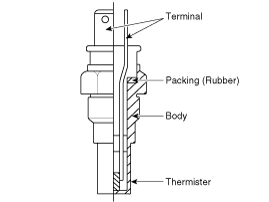Hyundai Kona: Engine Control System / Engine Coolant Temperature Sensor (ECTS) Description and operation
Hyundai Kona (OS) 2018-2025 Service Manual / Engine Control / Fuel System / Engine Control System / Engine Coolant Temperature Sensor (ECTS) Description and operation
| Description |
Engine Coolant Temperature Sensor (ECTS) is located in the engine coolant passage
of the cylinder head for detecting the engine coolant temperature. The ECTS
uses a thermistor that changes resistance with the temperature.
The electrical resistance of the ECTS decreases as the temperature increases,
and increases as the temperature decreases. The reference +5V is supplied to
the ECTS via a resistor in the ECM. That is, the resistor in the ECM and the
thermistor in the ECTS are connected in series. When the resistance value of
the thermistor in the ECTS changes according to the engine coolant temperature,
the output voltage also changes.
During cold engine operation, the ECM increases the fuel injection duration
and controls the ignition timing using the information of engine coolant temperature
to avoid engine stalling and improve drivability.

 Boost Pressure Sensor (BPS) Repair procedures
Boost Pressure Sensor (BPS) Repair procedures
Inspection
1.
Connect a GDS on the Data Link Connector (DLC).
2.
Measure the output voltage of the BPS at idle and IG ON.
...
 Engine Coolant Temperature Sensor (ECTS) Specifications
Engine Coolant Temperature Sensor (ECTS) Specifications
Specification
Temperature
Resistance (kΩ)
°C
°F
-40
-40
48.14
-20
...
Other information:
Hyundai Kona (OS) 2018-2025 Service Manual: Antenna Repair procedures
Removal
Roof Antenna
1.
Disconnect the negative (-) battery terminal.
2.
Remove the roof trim assembly.
(Refer to Body - "Roof Trim Assembly")
3.
Disconnect the roof antenna cable and conn ...
Hyundai Kona (OS) 2018-2025 Service Manual: Intake Air Temperature Sensor (IATS) Repair procedures
Inspection
1.
Turn the ignition switch OFF.
2.
Disconnect the IATS connector.
3.
Measure resistance between the IATS terminals 3 and 4.
4.
Check that the resistance is within the sp ...
© 2018-2025 www.hkona.com
